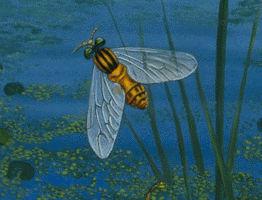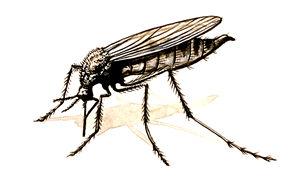Fly
Fly, term commonly applied to many actively flying INSECTS; restricted by scientists to 2-winged flies of order Diptera. This order includes BLACK FLIES, blow flies, bot flies, crane flies, deer flies, face flies, flesh flies, gnats, horn flies, horse flies, house flies, MIDGES, MOSQUITOES, no-see-ums, stable flies and warble flies. Four-winged "flies," eg, ALDERFLIES, BUTTERFLIES, CADDISFLIES, DAMSELFLIES, DRAGONFLIES, LACEWINGS, MAYFLIES, SAWFLIES, scorpionflies, snakeflies, STONEFLIES and whiteflies, are not true flies.Range
About 100 000 species of Diptera have been described worldwide; the actual number may be double that. Over 7000 species have been reported in Canada, a figure also estimated to represent only half the species present. Their relative abundance in the insect fauna increases northwards; in the most extreme arctic localities, they outnumber all other winged insects, both as species and as individuals. Flies range in size from 1 mm to 5.5 cm.Structure
The most obvious characteristic distinguishing true flies from other insects is the modification of the hind wings into knob-shaped gyroscopic organs (halteres), essential for maintaining balance in flight. These structures allow flies to perform outstanding feats of aerobatics (eg, landing upside-down on ceilings).Adult flies have sucking or piercing mouth parts and lack the mandibles with which other insects bite food.
Diet
It is thought that adult flies were, primitively, predators of other insects, using their mouth parts to pierce prey's integument (body covering) and that the habit of sucking vertebrate blood evolved from this. Many modern flies, including voracious predators such as robber flies and dance flies, still attack only other insects. Most predatory flies feed on carbohydrates, eg, honeydew and nectar, as well as on animal prey. Some flies have abandoned predation and use pollen (hover flies) or decaying material (house flies) as their protein source. Adult warble and bot flies do not feed, relying on fat reserves accumulated in the larval stage.
Reproduction and Development
Dipteran larvae are legless. Most are maggots living concealed within a moist substrate, but some hoverflies have free-living larvae, which prey on APHIDS. Specialized swimming larvae have evolved in mosquitoes and related groups of nonbiting midges. Most fly larvae feed on micro-organisms or decaying matter. A few are predatory or parasitic: larvae of marsh flies (sciomyzids) kill snails; those of horse flies (tabanids), robber flies (asilids) and dance flies (empidids) prey on other insect larvae; those of tachinids (parasitic flies) are specialized internal parasites, important in biological control of INSECT PESTS.
Although few groups of flies have evolved exclusively plant-eating larvae (notably fruit flies, gall midges and leaf-mining flies), those that have are unusually diverse and actively evolving. Among aquatic larvae, those of nonbiting midges form a major part of the INVERTEBRATE biomass in Canadian waters.
Interaction with Humans
The enlarged salivary glands of many Diptera contain giant chromosomes convenient for genetic studies. This trait, and their willingness to breed in bottles, make Drosophila a popular experimental animal.

 Share on Facebook
Share on Facebook Share on X
Share on X Share by Email
Share by Email Share on Google Classroom
Share on Google Classroom




